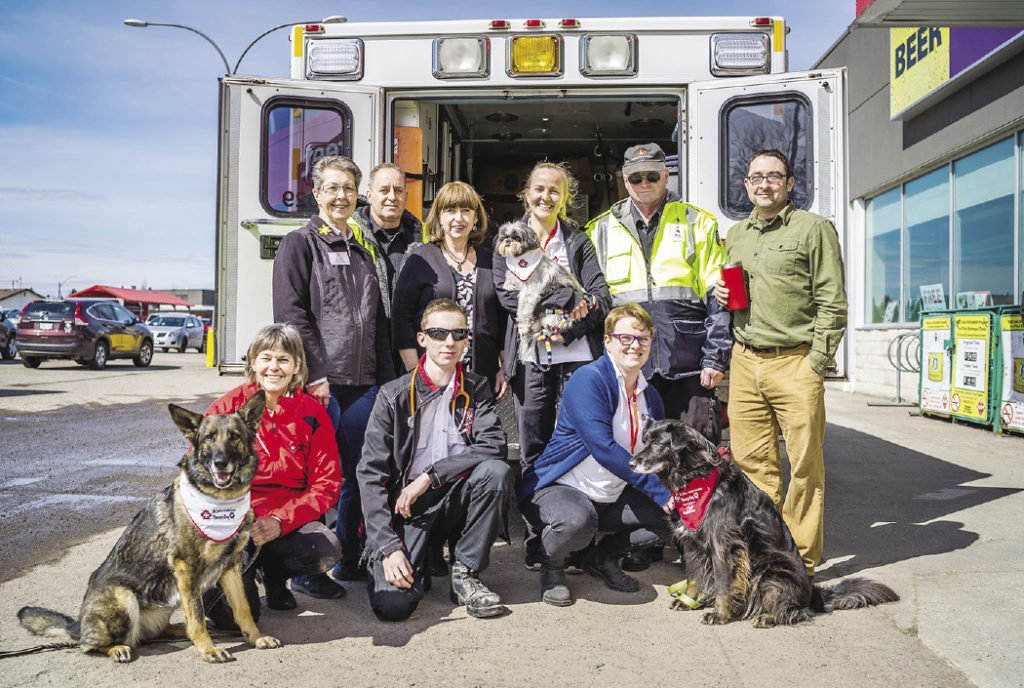Did you know there are currently more than 50 therapy dog teams (one dog and its owner/handler) of the St. John Ambulance Therapy Dog Program (SJA TDog) actively visiting in Thunder Bay and Northwestern Ontario? And across Canada, there are more than 3,300 therapy dog teams.
One important thing to know is there is a difference between a therapy dog and a service dog. A service dog is trained specifically to meet the needs of one individual owner; generally wear a harness that states “Service Dog—please do not pet” and, is trained to recognize when their person needs their help. Therapy dogs are there for people other than their owner.
Thunder Bay’s Jill Biggs is the owner of an eight-year-old German shepherd named Flynn, a therapy dog since age three.
“Two of the most important traits in a therapy dog are that they like people and they like attention” said Biggs. “Therapy dogs must be calm in a variety of situations, do not show any signs of aggression towards people or other dogs, do not jump up, paw, lick or pull on their leashes.”
Established in 1992, the SJA TDog Program started as a pilot program in Peterborough, Ontario. It has now become a recognized leader in animal-assisted intervention, reaching out to thousands of people across Canada in long-term care and mental health facilities, schools, universities, day care centres, colleges, hospitals, libraries, airports, and more. The SJA TDogs have been strictly evaluated for temperament and suitability as a therapy dog.
Wearing their trademark white and red scarf around their neck and collar, therapy dogs are welcomed regularly at places like Thunder Bay Regional Health Sciences Centre, St. Joseph’s Hospital, Thunder Bay Regional Airport, Lakehead University, Confederation College, Thunder Bay Police Station and Judge Lester Youth Correctional Centre, to name a few. As well as regularly scheduled visits, therapy dogs participate in wellness days, Operation Red Nose, Fill An Ambulance and a variety of community events.
Child-tested dogs visit day cares and elementary schools.

“Several dogs are involved in ‘Paw 4 Stories’ in which young students read books to the dogs,” says Biggs. “We know that dogs are not judgmental and students who are reluctant to read in front of an adult, especially a stranger, have no problem sitting beside a dog and reading to them.”
And how are the therapy dogs received on their visits? Biggs explains a good example is at the Lakehead University Paterson Library where therapy dogs visit on a weekly basis.
“When you walk into the library, even if you are well before the scheduled time, there will be students waiting to visit with the dogs. Quite often students will then text their friends to remind them that it is a dog visit day.”
Another example is when a dog visits a place such as St. Joseph Hospital.
“The visit often starts before we get in the door as people will stop and pat the dogs. The dogs are there to visit everyone—staff, patients and visitors. You know you make a difference when you walk in, and people call out, not your name but your dog’s!” said Biggs.
Benefits of a therapy dog program? Well, for starters, therapy dogs help a person’s social, emotional, physical and cognitive functioning. And for physical health, the act of petting produces an automatic relaxation response, lowers blood pressure, improves cardiovascular heath, slows breathing, increases serotonin and dopamine levels, and diminishes overall physical pain. And it was back in 1860 that the founder of modern nursing, Florence Nightingale, first recognized the benefits of animal-assisted therapy.
“Every therapy dog owner has stories of the moments they have experienced when their dogs are visiting. Seeing the smiles on people’s faces, hearing the stories of their dogs, alleviating loneliness and anxiety—all incredible experiences,” said Biggs.
To be part of the St. John Ambulance Therapy Dog Program or request a therapy dog visit, please contact the St. John’s Ambulance Thunder Bay & Northwestern Ontario Branch office. The program is totally volunteer-run community service, funded through donations and there is no cost for a therapy dog visit.
WOULD YOUR DOG QUALIFY TO BE A THERAPY DOG?
St. John Ambulance Therapy Dog Program in Thunder Bay holds two evaluation sessions each year (October and April). According to SJA, if you can answer “true” to each of the following statements, the evaluation should present no problem to you and your dog.
My dog:
- Is well-socialized with people and other dogs and can be in the same room with groups of them without displaying fear or aggression. My dog can meet another dog without displaying fear or aggression.
- Enjoys being petted by strangers and does not have any sensitive areas, i.e. head, face, tail, back and paws to which it would object to being touched while being petted by a stranger.
- Can walk confidently along a path with me, wearing a flat buckle collar on a loose leash without pulling, without being distracted by others or switching sides to impede me.
- Can walk comfortably with me and without pulling through a crowded hallway.
- Does not jump up on people and, if excited, can be calmed by me in a short time.
- Would not be upset by people wearing or using things that are common in a hospital or ongoing-term care facility such as hats, canes, walkers, uniforms, robes, wheelchairs.
- Does not mind several people petting it at one time.
- If startled by a loud noise or disturbance, such as a metal bowl being dropped, can recover without displaying aggression.
- If offered a treat by a person holding it in their fingers, it will (if it does take it) do so gently without lunging or chewing on the fingers to get it.
Telephone: 807-345-1712; toll-free 1-800-667-6246.

